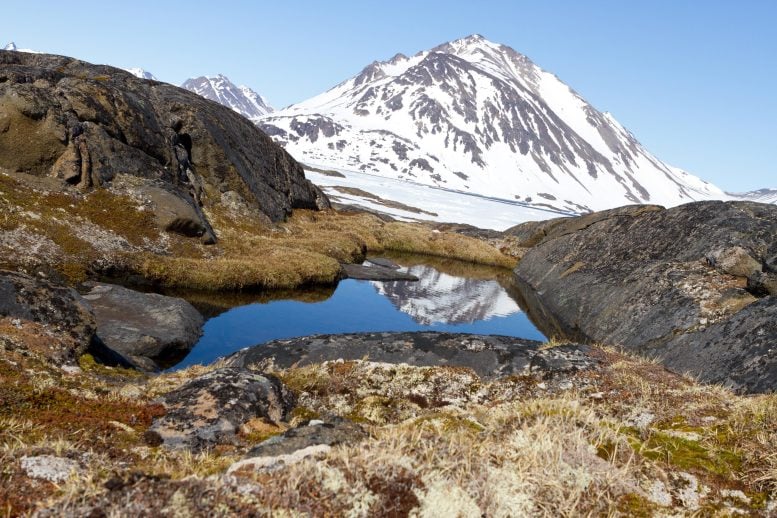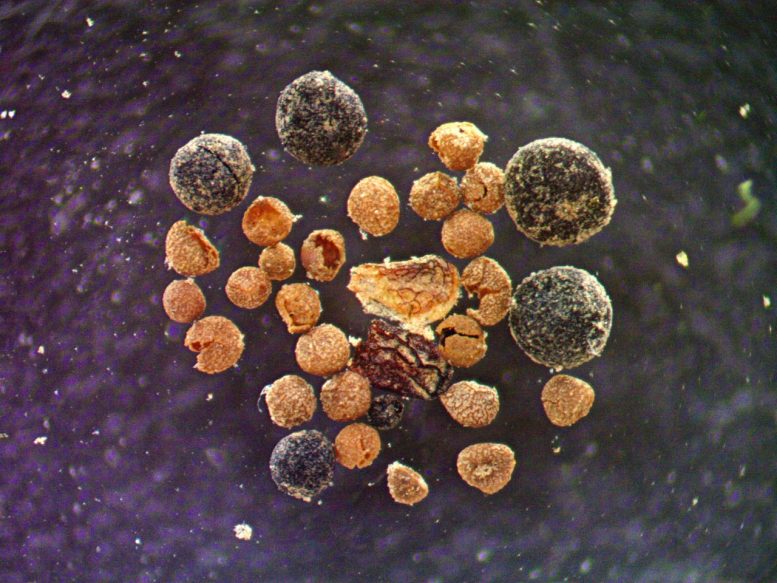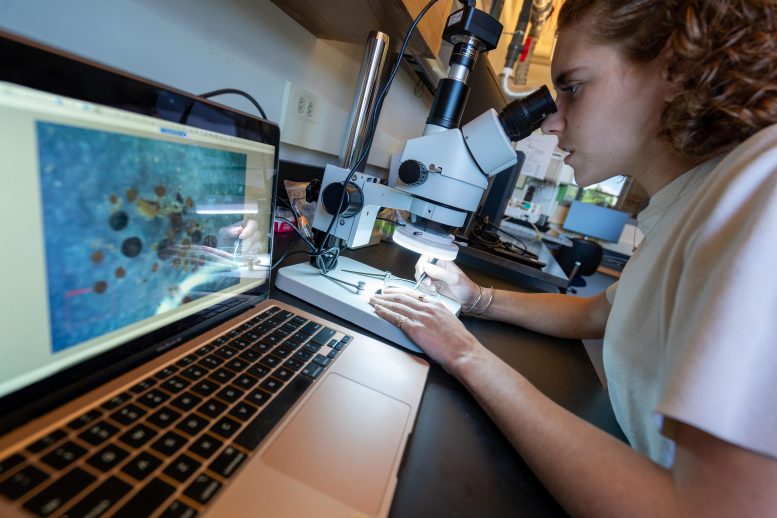
New evidence shows Greenland’s ice sheet once melted completely, revealing a tundra below. This suggests increased vulnerability to climate change and significant potential sea level rises.
New research provides the first direct evidence that the center, not just the edges, of Greenland’s ice sheet melted in the recent geological past and the now-ice-covered island was then home to a green, tundra landscape.
Surprising Geological Discoveries
In the study, published in the Proceedings of the National Academy of Sciences on August 5th, the scientists re-examined a few inches of sediment from the bottom of a two-mile-deep ice core extracted at the very center of Greenland in 1993. They were amazed to discover soil that contained willow wood, insect parts, fungi, and a poppy seed in pristine condition.
“These fossils are beautiful,” says Paul Bierman, a scientist at the University of Vermont who co-led the new study with UVM graduate student Halley Mastro and nine other researchers, “but, yes, we go from bad to worse,” in what this implies about the impact of human-caused climate change on the melting of the Greenland ice sheet.

Implications for Global Sea Levels
These findings confirm that Greenland’s ice melted and the island greened during a prior warm period likely within the last million years, suggesting that the giant ice sheet is more fragile than scientists had realized.
If the ice covering the center of the island was melted, then most of the rest of it had to be melted too. “And probably for many thousands of years,” Bierman said, enough time for soil to form and an ecosystem to take root.
“This new study confirms and extends that a lot of sea-level rise occurred at a time when causes of warming were not especially extreme,” said Richard Alley, a leading climate scientist at Penn State who reviewed the new research, “providing a warning of what damages we might cause if we continue to warm the climate.”
Sea level today is rising more than an inch each decade. “And it’s getting faster and faster,” said Bierman. It is likely to be several feet higher by the end of this century, when today’s children are grandparents. And if the release of greenhouse gases—from burning fossil fuels—is not radically reduced, he said, the near complete melting of Greenland’s ice over the next centuries to a few millennia would lead to some 23 feet of sea level rise.
“Look at Boston, New York, Miami, Mumbai, or pick your coastal city around the world, and add twenty plus feet of sea level,” said Bierman. “It goes underwater. Don’t buy a beach house.”

Reevaluating the Age of Greenland’s Ice
In 2016, Joerg Schaefer at Columbia University and colleagues tested rock from the bottom of the same 1993 ice core (called GISP2) and published a then-controversial study suggesting that the current Greenland ice sheet could be no more than 1.1 million years old; that there were extended ice-free periods during the Pleistocene (the geological period that began 2.7 million years ago); and that if the ice was melted at the GISP2 site then 90% of the rest of Greenland would be melted also. This was a major step toward overturning the longstanding story that Greenland is an implacable fortress of ice, frozen solid for millions of years.
Then, in 2019, UVM’s Paul Bierman and an international team reexamined another ice core, this one extracted at Camp Century near the coast of Greenland in the 1960s. They were stunned to discover twigs, seeds, and insect parts at the bottom of that core—revealing that the ice there had melted within the last 416,000 years. In other words, the walls of the ice fortress had failed much more recently than had been previously imagined possible.
Evidence of Past Tundra Ecosystems
“Once we made the discovery at Camp Century, we thought, ‘Hey, what’s at the bottom of GISP2?’” said Bierman, a professor in UVM’s Rubenstein School of Environment and Natural Resources and fellow in the Gund Institute for Environment. Though the ice and rock in that core had been studied extensively, “no one’s looked at the 3 inches of till to see if it’s soil and if it contains plant or insect remains,” he said. So he and his colleagues requested a sample from the bottom of the GISP2 core held at the National Science Foundation Ice Core Facility in Lakewood, Colorado.
Now this new study in PNAS, with support from the U.S. National Science Foundation, provides confirmation that the 2016 “fragile Greenland” hypothesis is right. And it deepens the reasons for concern, showing that the island was warm enough, for long enough, that an entire tundra ecosystem, perhaps with stunted trees, established itself where today ice is two miles deep.
“We now have direct evidence that not only was the ice gone, but that plants and insects were living there,” said Bierman. “And that’s unassailable. You don’t have to rely on calculations or models.”
Uncovering the Past
The initial discovery that there was intact biological material—not just gravel and rock—in the bottom of the ice core was made by geoscientist Andrew Christ who completed his PhD working at UVM and was a post-doctoral associate in Bierman’s lab. Then Halley Mastro picked up the case and began to study the material closely.
“It was amazing,” she said. Under the microscope, what had looked like no more than specks floating on the surface of the melted core sample, was, in fact, a window into a tundra landscape. Working with Dorothy Peteet, an expert on macrofossils at the Lamont-Doherty Earth Observatory and co-author on the new study, Mastro was able to identify spores from spikemoss, the bud scale of a young willow, the compound eye of an insect, “and then we found Arctic poppy, just one seed of that,” she said. “That is a tiny flower that’s really good at adapting to the cold.”
But not that good. “It lets us know that Greenland’s ice melted and there was soil,” said Mastro, “because poppies don’t grow on top of miles of ice.”
Reference: “Plant, insect, and fungi fossils under the center of Greenland’s ice sheet are evidence of ice-free times” by Paul R. Bierman, Halley M. Mastro, Dorothy M. Peteet, Lee B. Corbett, Eric J. Steig, Chris T. Halsted, Marc M. Caffee, Alan J. Hidy, Greg Balco, Ole Bennike and Barry Rock, 5 August 2024, Proceedings of the National Academy of Sciences.
DOI: 10.1073/pnas.2407465121
4 Comments
“Then, in 2019, UVM’s Paul Bierman and an international team reexamined another ice core, this one extracted at Camp Century NEAR the coast of Greenland in the 1960s.”
‘Near’ if you consider 150 miles from the coast to be “near.” Dr. Chester Langway, project scientist with the U. S. Army Cold Regions Research and Engineering Laboratory, was aware of the significance in 1966 and separated the bottom material from the rest of the ice core for archiving.
Readers might be interested in more information on Camp Century:
https://en.wikipedia.org/wiki/Camp_Century
There were also tunnels driven into the ice at Camp Tuto, actually near the coast, for which I had the privilege of being assigned the supervisory role of the last annual ice closure survey in 1966. The real work was done by other soldiers living at Camp Tuto in the Summer and surveying the main tunnel with transits at bone-chilling temperatures of (IIRC) about 27 deg F with high humidity while working.
“Sea level today is rising more than an inch each decade. “And it’s getting faster and faster,” said Bierman.”
As to whether of not it is accelerating is debatable.
https://wattsupwiththat.com/2024/08/11/variation-of-50-year-relative-sea-level-trends-northeast-united-states/
“It is likely to be several feet higher by the end of this century, …”
With a little over 7 decades to the end of the century, and a current rate of increase of “more than an inch each decade,” that gives something over 7 inches by the end of the century. Considering that the necessary acceleration is problematic, to achieve several feet in rise there needs to be good evidence of some process to accelerate the ‘acceleration.’ Hand waving isn’t sufficient.
Imagine Greenland becoming green again, as it was when it got its name… Oh, the terror!
MGGA – Make Greenland Green Again!